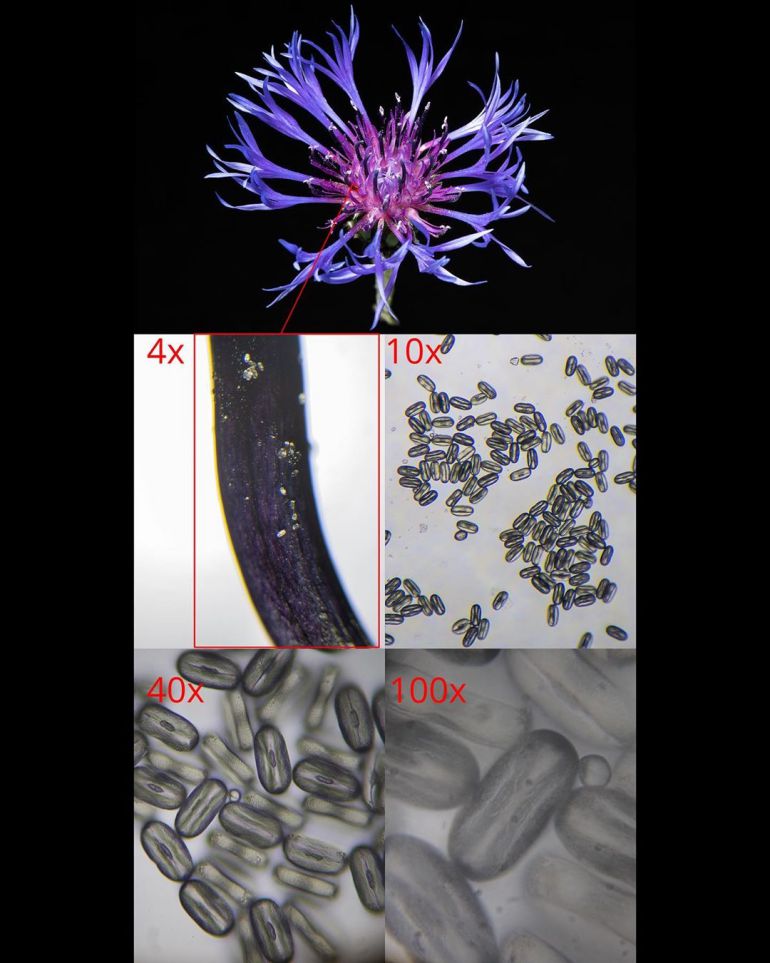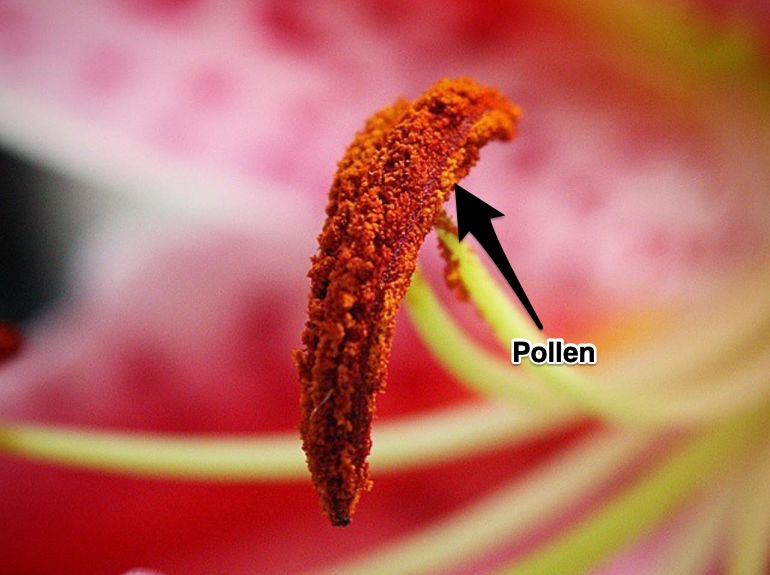What does pollen look like depends much on the kind of plant that is making the pollen. Though most often pollen is blamed on flowers, flowers and flowering trees tend to have larger pollen particles that don’t as quickly get in your sinuses to bother you.

Pollen of Centaurea Montana
On the other hand, trees and grass that actually don’t make large and visible flowers are still quite capable of making tons of pollen. They are so small that it is easy to breathe in without even noticing.
A birch tree is a classic example of this, birch pollen being one of the top allergens after grass. But what does birch pollen look like if the tree has no flowers? The truth is that while birch tree may not have flowers in the sense that we usually think of flowers, they do have their own way of ‘blooming’. These clusters of blooms are called catkins, and they release tons of microscopically small pollen particles.
What does pollen look like under a microscope
Pollen can come in a variety of shapes and sizes; some are large enough to be seen with the naked eye while others require a good microscope to see. Some grass pollens look like tiny dodge balls, with some varieties looking as though the dodge ball has been partially deflated.

Pollen of Birch tree under a microscope
Birch pollen looks somewhat like this as well, only it is covered with tiny bumps that can help it to cling to what it lands on better. Hellebore pollen grains look similar to brain coral as do cucumber pollens, though to a lesser degree. Others can even look like pasta shells or even walnuts!
Where does pollen come from and what does it do?
Pollen comes from the stamen part of flowers and is the male part of the plant made up of the anther and the filament on which the anther sits. When pollination happens, either with the help of bees, butterflies, or wind, this means that the pollen from the anther is in some way transferred to the stigma which is the female part of the plant.

Lily anthers

The pollen on the anthers
The anther part of a flower in most cases is easily identified by the bright yellow color and powdery look that the pollen gives the anthers.
Once pollinated, the stigma is then able to develop the seed or fruit inside. Meanwhile, an un-pollinated stigma cannot produce fruit. This is how we get fruits like apples, pineapples, lemons, and many more. Palynology is the study of pollen and classifies the different kinds of pollen and spores as well as what bugs and insects pollinate them and how they work.
Signs you are allergic to pollen and what to do for it
While there are a wide variety of symptoms you can have, these tend to range from mild to severe and sometimes it can be difficult to point out precisely what it is you are reacting to. Some of the milder symptoms tend to be things like a runny or itchy nose, frequent sneezing, and itchy or red eyes, but you can also get mild headaches.
Worse symptoms are often referred to as hay fever and can be severe headaches and all the symptoms that come with a bad cold or flu. In the worst cases, the allergy to pollen can even cause a new allergy to develop to certain foods like apples, cherries, nuts, or even things like celery in people who were not allergic to those foods at all before.
There are ways to mitigate the amount of pollen you inhale, and antihistamines and decongestants can be helpful in controlling the symptoms in situations where it cannot be avoided. There are sites you can go to in order to check the pollen forecast and during high pollen times be careful to keep your windows shut and to avoid leaving the door open.
Also, when in your vehicle be sure to use your air conditioner, making sure that the filters have been changed regularly, instead of driving with the windows down.
When outdoors during peak pollen times try wearing a face mask or scarf. If doing this in public would make you feel uncomfortable, then try placing a dab of Vaseline or something similar just on the inside of your nose to act as a pollen trap, this will help prevent you from inhaling the pollen.
Changing clothes when you come inside and brushing pet’s fur will help prevent pollen from spreading in the house, and there are pet shampoos that are specifically meant to help neutralize pollen.
In severe cases where preventative measures do not seem to make enough of a difference, you should always talk to your doctor who might be able to help you pinpoint specific pollen that is to blame and prescribe you something that will help with the symptoms.
- How to Get Rid of Wood Mites - September 24, 2020
- Can You Have Stained Doors With Painted Trim? - May 27, 2020
- Is Duct Tape Flammable? and Other Burning Questions About Duct Tape - April 2, 2020
